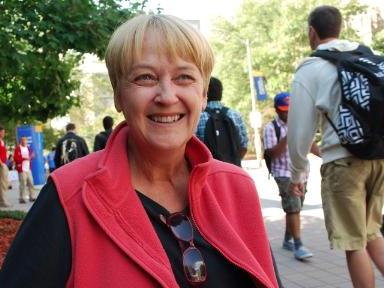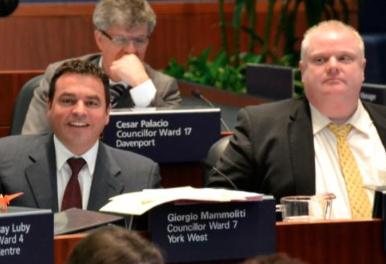
Cathy Crowe says the city has no money to implement Mammoliti's plans for the homeless. Credit: Andrea Houston
Some experts say that Councillor Giorgio Mammoliti’s plans to do away with the city’s shelter system and clear Toronto’s sidewalks of the homeless could have upsetting consequences for gay people living on the streets.
Mammoliti, who is chair of Mayor Rob Ford’s homelessness task force, brought these points forward July 6 as he began work with the group.
He has proposed moving homeless people off the streets and into transitional housing, by force if necessary. He also plans to close Toronto’s shelters and replace them with transitional housing.
One expert on homelessness in Toronto says there are currently many queer people living on the city’s streets and accessing city services.
“People do not have a strong understanding of the connection between homophobia and homelessness,” says Alex (Ilona) Abramovich, a PhD candidate at the Ontario Institute for Studies in Education at University of Toronto. Abramovich, whose research focuses on queer youth homelessness in Toronto, says many queer youth end up in shelters when they come out of the closet and are kicked out by parents or guardians.
The city directly operates nine of 57 local shelters. Rather than outsourcing the shelters, Mammoliti is insisting they be shut down.
He instead favours transitional housing, which offers intensive case management and support services for those who are making the change into more stable housing. Mammoliti, however, has not said where he expects people to transition after the time-limited program ends. He did not respond to requests for comment.
“The bottom line is there’s not a lot of affordable housing options for people who are marginalized or in great need of complex care,” says Keith Hambly, executive director of Fife House.
A provider of affordable housing and services to those living with HIV/AIDS in the Greater Toronto Area, Fife House has worked with the city through the Homeless Outreach Program for more than a decade. The program supports homeless or marginally housed people in their searches for appropriate housing. “It is an acknowledgment by the city of the specific homelessness issues for the HIV-positive community,” Hambly says. The program is funded by the city and through Fife House’s fundraising activity.
“For the HIV-positive, you need a stable housing environment in which to stabilize your health, get reconnected to primary healthcare assistance and then work on whatever other issues that you may be facing,” he says.
Mammoliti also wants to see an end to Toronto Community Housing, the largest social-housing provider in the country. In addition, he is calling for more enforcement to get people off the streets.
The proposed changes come as no surprise to housing advocates who have seen homelessness and housing issues fall off the priority list of recent City of Toronto administrations. Cathy Crowe, a street nurse and the cofounder of the Toronto Disaster Relief Committee, has been fighting for years for improved shelter facilities in the city.
Crowe remembers with fondness the days when Jack Layton chaired the Homeless Advisory Committee. She says housing and homelessness have not been given much prominence since. “That was a huge period of policy wins in response to community pressure,” Crowe says, noting that, in theory, those years brought an end to discrimination within the shelter system.
Discrimination nevertheless persists. A high proportion of queer homeless youth report feeling safer on the streets than in shelters due to the homophobic and transphobic violence that occurs in the shelter system. “There are some folks who may have experienced discrimination or stigma within the shelter system and are reticent to go back to a sector where they didn’t feel supported,” Hambly says.
Meanwhile, Crowe says she is bewildered at Mammoliti’s planned housing changes because of a noticeable lack of details and funds. “There are no proposed housing changes in what Mammoliti is talking about,” she says. “The city has no money to transform shelters into housing. He simply doesn’t know what he’s talking about.”
Abramovich agrees, noting that without housing there is very little of substance that can be done for the homeless queer community.
“If Mammoliti’s plan to place all homeless people into transitional housing is successful, it will be imperative that the city also implements specialized LGBTQ transitional housing,” Abramovich says.


 Why you can trust Xtra
Why you can trust Xtra


